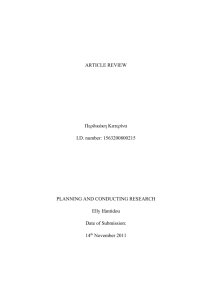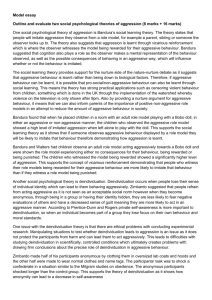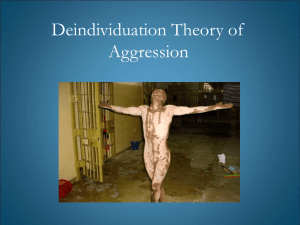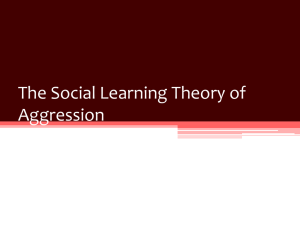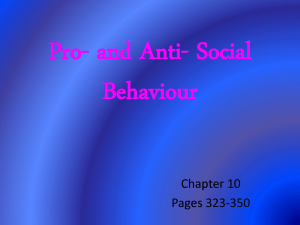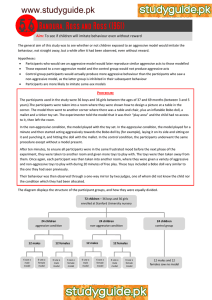File
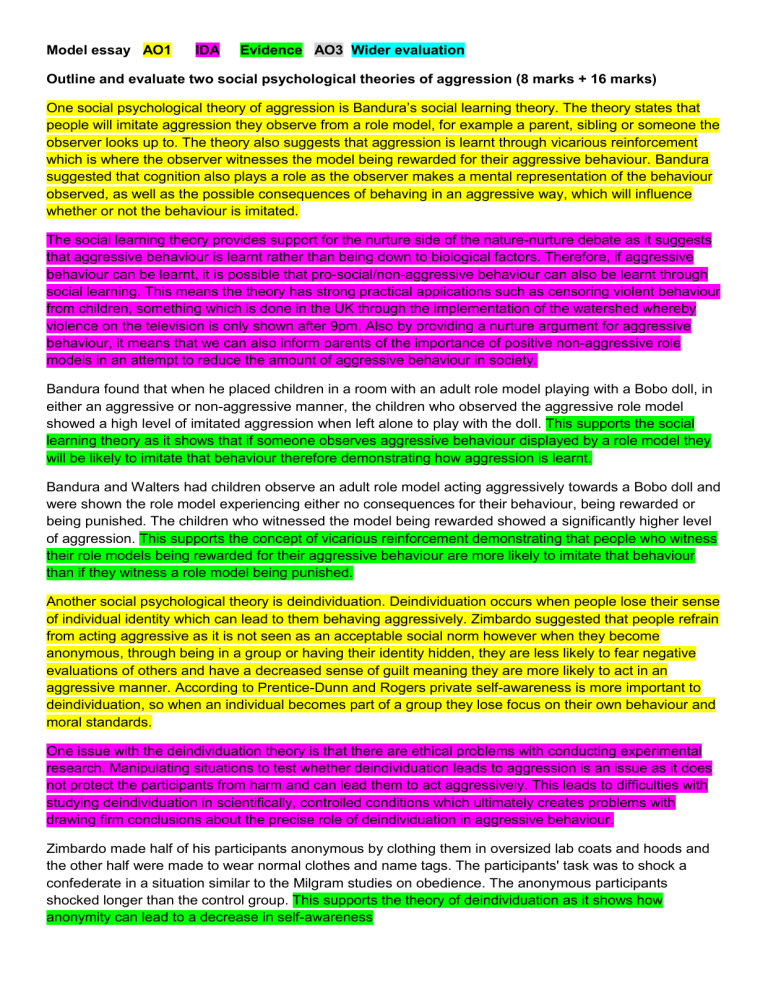
Model essay AO1 IDA Evidence AO3 Wider evaluation
Outline and evaluate two social psychological theories of aggression (8 marks + 16 marks)
One social psychological theory of aggression is Bandura’s social learning theory. The theory states that people will imitate aggression they observe from a role model, for example a parent, sibling or someone the observer looks up to. The theory also suggests that aggression is learnt through vicarious reinforcement which is where the observer witnesses the model being rewarded for their aggressive behaviour. Bandura suggested that cognition also plays a role as the observer makes a mental representation of the behaviour observed, as well as the possible consequences of behaving in an aggressive way, which will influence whether or not the behaviour is imitated.
The social learning theory provides support for the nurture side of the nature-nurture debate as it suggests that aggressive behaviour is learnt rather than being down to biological factors. Therefore, if aggressive behaviour can be learnt, it is possible that pro-social/non-aggressive behaviour can also be learnt through social learning. This means the theory has strong practical applications such as censoring violent behaviour from children, something which is done in the UK through the implementation of the watershed whereby violence on the television is only shown after 9pm. Also by providing a nurture argument for aggressive behaviour, it means that we can also inform parents of the importance of positive non-aggressive role models in an attempt to reduce the amount of aggressive behaviour in society.
Bandura found that when he placed children in a room with an adult role model playing with a Bobo doll, in either an aggressive or non-aggressive manner, the children who observed the aggressive role model showed a high level of imitated aggression when left alone to play with the doll. This supports the social learning theory as it shows that if someone observes aggressive behaviour displayed by a role model they will be likely to imitate that behaviour therefore demonstrating how aggression is learnt.
Bandura and Walters had children observe an adult role model acting aggressively towards a Bobo doll and were shown the role model experiencing either no consequences for their behaviour, being rewarded or being punished. The children who witnessed the model being rewarded showed a significantly higher level of aggression. This supports the concept of vicarious reinforcement demonstrating that people who witness their role models being rewarded for their aggressive behaviour are more likely to imitate that behaviour than if they witness a role model being punished.
Another social psychological theory is deindividuation. Deindividuation occurs when people lose their sense of individual identity which can lead to them behaving aggressively. Zimbardo suggested that people refrain from acting aggressive as it is not seen as an acceptable social norm however when they become anonymous, through being in a group or having their identity hidden, they are less likely to fear negative evaluations of others and have a decreased sense of guilt meaning they are more likely to act in an aggressive manner. According to Prentice-Dunn and Rogers private self-awareness is more important to deindividuation, so when an individual becomes part of a group they lose focus on their own behaviour and moral standards.
One issue with the deindividuation theory is that there are ethical problems with conducting experimental research. Manipulating situations to test whether deindividuation leads to aggression is an issue as it does not protect the participants from harm and can lead them to act aggressively. This leads to difficulties with studying deindividuation in scientifically, controlled conditions which ultimately creates problems with drawing firm conclusions about the precise role of deindividuation in aggressive behaviour.
Zimbardo made half of his participants anonymous by clothing them in oversized lab coats and hoods and the other half were made to wear normal clothes and name tags. The participants' task was to shock a confederate in a situation similar to the Milgram studies on obedience. The anonymous participants shocked longer than the control group. This supports the theory of deindividuation as it shows how anonymity can lead to a decrease in self-awareness
A criticism of the studies that support the SLT is that they were conducted in an artificial setting, for example, in the Bandura and Walters study the children were placed in a controlled environment whereby they witnessed an unfamiliar adult attacking a Bobo doll. This means the findings on aggression being learnt through the process of social learning is limited to the experimental setting that it was carried out in, thus making it difficult to generalise the findings of this research to real life aggression. This reduces the external validity of the evidence and leads us to question the extent to which we can use the social learning theory to explain real life aggression.
A further issue with the social learning theory is that it can be seen as socially sensitive. This is because it suggests that people become aggressive because they have observed and imitated the behaviour from a role model which can ultimately lead to aggressive behaviour being blamed on external factors such as the parents of children who are aggressive. This is somewhat controversial as there is evidence to suggest that there is a biological link to aggression therefore it would be wrong to blame aggression purely observational learning.
